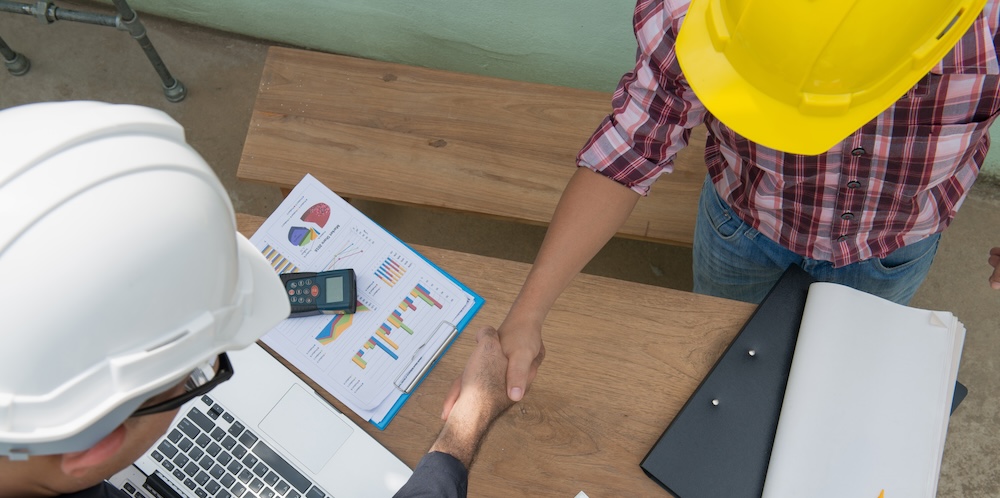— 8 min read
Winning Bids with BIM: Marketing the Benefits to Owners
Last Updated Feb 14, 2025
Last Updated Feb 14, 2025

Creating a 3D model of a construction project is becoming more common but, that doesn’t mean that all projects leverage BIM – or, that all companies are using BIM in the same ways.
Most construction firms with a BIM manager, or some other dedicated modeling department, will model at least part of the project. The added layer of planning sophistication that it offers doesn’t just help after groundbreak. It also has the potential to help them land contracts.
That said, even companies with well-established virtual design and construction (VDC) departments aren’t very frequently developing new models during project pursuit. The time and effort required for model development is still a risk when no return is guaranteed.
That doesn’t mean, however, that companies aren’t winning bids with BIM. While it’s rare — particularly in the U.S. — to develop a new model as a part of project pursuit, there are some instances in which it makes sense.
Table of contents
The Status Quo: BIM Development After Contract
It’s uncommon in the U.S. for firms to invest in a model before a contract is in place. Without the award in hand, there’s no certainty that the time and energy their team invests will see a return.
We see a trend of firms that are already contracted participating in a BIM effort. That could be a general contractor that has already been selected by the owner or that could be a trade partner that is helping with that design effort.
Bruno Pasini
Senior Solutions Engineer, Overlay, PM & Preconstruction
Procore
Globally, though, firms are winning bids with BIM. In the Europe, Middle East, and Africa (EMEA) and Asia–Pacific (APAC) regions, companies more commonly use BIM earlier in the project lifecycle. A recent case study, for example, evaluated how deploying a BIM strategy increased the likelihood of winning bids in Saudi Arabia. It found that utilizing BIM increased the probability of winning by 9.42% for qualifications-based selection (QBS) projects and by 5.5% for cost-based selection projects.
Even in the United States, where it’s rarer to undertake new BIM efforts to win bids, some firms are taking steps here. Researchers at Brigham Young University (BYU) looked at “The Use of Building Information Modeling in Generating Hard Bid Estimates” in 2010. That study concluded, “While BIM is not being used very frequently at present for detailed estimates, the data indicated that contractors are incorporating it into their procedures.”
That was 15 years ago. As with most things in the construction industry, change has come slowly here. To date, it’s still rare in the U.S. for firms to develop a model without having a contract in place.
Using BIM in the Design Phase
There are absolutely instances, though, when a model is developed before a general contractor (GC) is awarded a project. In fact, when a project will leverage a 3D model, that model often gets created during the architectural design process.
This might mean early access to it for the construction team, particularly on design-build projects. In fact, some design-build firms will even tap the construction team to help with the design effort and modeling, advising on issues like constructibility.
With this early development and deployment of the model, steps in the construction process can get streamlined. The model enables data-informed construction sequencing, for example, making it faster and easier to develop a strong schedule. It can also power 3D takeoffs, automating the otherwise laborious takeoff process.
Using Past BIM Efforts As Marketing Collateral
While most American firms aren’t creating new models pre-contract, they can still win bids with BIM. That means showcasing BIM efforts from past projects to use as marketing collateral.
BIM can help you win more bids, given the quality of your work and the precision of your work, which can only be achieved if you’re a company that is fluent in a 3D universe. Once you master that type of technology and you become the outlier, you will be the one that stands out.
Bruno Pasini
Senior Solutions Engineer, Overlay, PM & Preconstruction
Procore
Having a BIM portfolio proves to owners that the company has BIM expertise. If those sample models come from the same type of project as the one the company’s pursuing, all the better. Healthcare construction is notably complex, for example. Showing models from past healthcare builds can help firms differentiate themselves, providing evidence of their experience in a convincing way.
BIM serves as particularly useful marketing collateral for owners who don’t come from a construction background. When they’re not experienced at looking at drawings and specifications, 3D models help them visualize what to expect from the firm. By showing, rather than telling, what they can do, the company gets a meaningful communication channel. This can make a major difference in project pursuit.
Using previous projects’ BIM can power effective marketing, but it’s important to consider relationships with those past projects’ owners before moving forward. The firm should either get permission from the owner to share details of the project or white-label the model so that it doesn’t disclose any potentially proprietary information.
The Current Outlier: Creating New Models To Win Bids
While most U.S. firms see new BIM creation as too costly — and, consequently, high-risk — to undertake before a contract is awarded, this isn’t universally true. Taking notes from companies in EMEA and APAC, some companies are deploying BIM earlier in the project lifecycle.
Modeling the project in full before the contract is awarded is very rare. Companies will usually only sink that many resources into project pursuit when the project is particularly complex and large. Even when they do, the model is usually very conceptual, with details to be added after the contract is in place.
More frequently, companies will decide to model one or a few fragments of the project. That might mean modeling the structural steel sequencing, for example, to showcase expertise there. By modeling parts of the project that are important to the owner or require an extra level of care or competency, the company has a way to differentiate their bid from competitors’.
This is generally most effective for QBS situations. If the owner will choose the low-cost bid, models won’t move the needle.
BIM Benefits the Owner Can See
Whether companies showcase their BIM capabilities from past projects in their marketing efforts or model a fragment during project pursuit, it can open the door to tell the owner about the benefits of BIM.
Those include:
Risk mitigation
The model enables better sequencing, visualization to make it easier to spot safety hazards, clash detection, and more. For owners concerned about keeping the project on schedule and on budget, BIM is a valuable tool to proactively prevent risk.
Value engineering
The model can serve as a way to compare different construction methods, materials, equipment, etc., allowing the owner to make data-informed value engineering decisions.
Strategic scheduling
By modeling the project in 3D, teams gain a valuable tool for sequencing. They can see how things need to be installed, and when other components in the area might pose a problem. With a model-backed schedule, the project should be able to move forward with fewer obstacles.
Efficiency gains
Because BIM can speed processes like material takeoffs and automatically do work like clash detection, it can help teams move both more quickly and more precisely. Those efficiency gains help the project stay on schedule and on budget, a boon to any owner.
Facility management after closeout
The model can get handed to the owner at closeout, which can support the building’s lifecycle management efforts. Feeding the model into the owner’s computerized maintenance management system (CMMS), for example, can help workers service equipment on the right schedule — and locate that equipment more easily if it’s hidden behind a wall or ceiling.
Clean BIM Data for Project Pursuit and Beyond
Assuming American companies follow the rest of the world, they will more frequently use BIM for project pursuit. Getting good results here — both in terms of getting awarded the contract and for the success of the project moving forward — relies on quality data.
If teams want to expedite the process of estimating by leveraging BIM, they must maintain clean historical cost and estimating data. Clean models allow them to streamline the estimating process by utilizing the model effectively. Ensuring data hygiene guarantees the usability and accuracy of future estimates.
Bruno Pasini
Senior Solutions Engineer, Overlay, PM & Preconstruction
Procore
Clean, well-structured data is key for effective BIM implementation. Without it, the model might not align with the owner’s expectations. There, it could hurt rather than help the company’s odds of winning the bid.
And should they get awarded the contract, clean data they can trust gets even more important. Without data hygiene, the team won’t be able to leverage the model for efficiency gains like clash detection and automated 3D takeoffs.
In short, the cleaner the data in the model, the smoother and more accurate the process.
As the BYU study concluded, “BIM is certain to have a future in construction and a future in estimating. Nearly all of the contractors in this study felt that it is inevitable that BIM will be used for estimating in the future and that it will eventually be able to deliver all of the promised benefits. However, there is work that certainly needs to be done to get the construction industry to that point.”
The energy firms aren’t investing in pre-contract modeling today may be better directed toward implementing strong data practices. Keeping data organized and digestible positions the company to thrive as BIM becomes more commonplace.
Was this article helpful?
Thank you for your submission.
100%
0%
You voted that this article was . Was this a mistake? If so, change your vote here.
Scroll less, learn more about construction.
Subscribe to The Blueprint, Procore’s construction newsletter, to get content from industry experts delivered straight to your inbox.
By clicking this button, you agree to our Privacy Notice and Terms of Service.
Categories:
Written by
Bruno Pasini
Bruno Pasini is a Solutions Engineer at Procore, where he develops new tools to simplify and streamline the preconstruction process. He spent nearly 20 years as an estimator and project manager for general contractors and specialty contractors in New York and California. He currently lives in San Diego.
View profileKacie Goff
54 articles
Kacie Goff is a construction writer who grew up in a construction family — her dad owned a concrete company. Over the last decade, she’s blended that experience with her writing expertise to create content for the Construction Progress Coalition, Newsweek, CNET, and others. She founded and runs her own agency, Jot Content, from her home in Ventura, California.
View profileExplore more helpful resources

Mastering Construction Bid Templates to Simplify the Process and Win More Work
Every construction project is different. Different set of challenges, timelines, key players, etc. Because every project is different, what project owners need to know from a bid will differ based...

How To Improve Your Bid-Hit Ratio: 5 Strategies To Deploy
The bidding process is a necessary part of the construction game for any general or specialty contractor. Without bidding jobs and getting awarded contracts, the company doesn’t have a way...

How Pre-Bid Meetings Impact Construction Bidding
Deciding to bid on construction jobs is not a decision contractors take lightly. There are many factors to consider in what constitutes the “right” project. Location, project type, available resources...

The Hidden Cost of Construction Bid Shopping
On any construction project, a general contractor (GC) has an overarching goal: complete the required work with a profit margin. Because very few GCs self-perform a project in its entirety,...